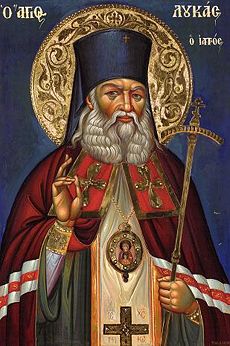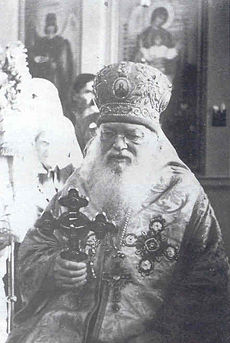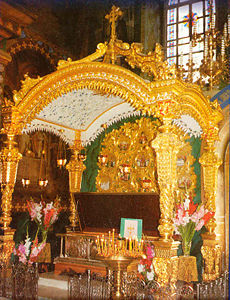Difference between revisions of "Luke (Voino-Yasenetsky) of Simferopol and Crimea"
(→The Saint's last words) |
(added article "Science and Religion" to external links) |
||
| Line 103: | Line 103: | ||
* NASA Jet Propulsion Laboratory. [http://ssd.jpl.nasa.gov/sbdb.cgi?sstr=6161 6161 Vojno-Yasenetsky (1971 TY2)]. (''Main-belt Asteroid 6161, discovered on Oct. 14 1971 by L.I. Chernykh at the Crimean Astrophysical Observatory, was named in memory of Valentin Feliksovich Vojno-Yasenetsky (1877-1961), surgeon and bishop'') | * NASA Jet Propulsion Laboratory. [http://ssd.jpl.nasa.gov/sbdb.cgi?sstr=6161 6161 Vojno-Yasenetsky (1971 TY2)]. (''Main-belt Asteroid 6161, discovered on Oct. 14 1971 by L.I. Chernykh at the Crimean Astrophysical Observatory, was named in memory of Valentin Feliksovich Vojno-Yasenetsky (1877-1961), surgeon and bishop'') | ||
* V Kogan. ''[http://journals.elsevierhealth.com/periodicals/ymai/medline/record/MDLN.11620503 Two letters of V.P. Filatov to V.F. Voino-Yasenetsky]''. In '''Agapit.''' January 1996, Issue 4, pp.65-69. (''History, 20th Century; Portraits; Religion and Medicine; Ukraine'') | * V Kogan. ''[http://journals.elsevierhealth.com/periodicals/ymai/medline/record/MDLN.11620503 Two letters of V.P. Filatov to V.F. Voino-Yasenetsky]''. In '''Agapit.''' January 1996, Issue 4, pp.65-69. (''History, 20th Century; Portraits; Religion and Medicine; Ukraine'') | ||
| + | * [http://www.impantokratoros.gr/8C1597E5.en.aspx "Science and Religion"] An article by St Luke on the compatibility of science and religious faith. | ||
| + | |||
'''YouTube Video in Greek''' | '''YouTube Video in Greek''' | ||
Revision as of 19:34, February 10, 2010
Saint Luke, Bishop of Simferopol and Crimea, the Blessed Surgeon, was born Valentin Felixovich Voino-Yasenetsky (Валентин Феликсович Войно-Ясенецкий, Βαλεντίν Βόϊνο-Γιασενέτσκι), April 14, 1877 and died June 11, 1961.
Doctor of Medicine, Professor, and State Prize winner, since 1944 he was the Archbishop of Tambov and Michurinsk, and later of Simferopol and the Crimea. While he was serving the church as an Archbishop, he was also practicing as a surgeon and taught and published many books and articles on regional anesthesia and surgery. He is now known to be a world-famous pioneering surgeon.
In November of 1995 he was announced as a Saint by the Ukrainian Orthodox Church, and was officially glorified by the Patriarchate of Russia May 25, 1996. He is commemorated by the church June 11 the anniversary of his falling asleep in the Lord.
Contents
Life
“I ought to tell you that what God did to me as amazing and incomprehensible…. My pursuing surgery completely satisfied the goal I always had to serve the poor and the suffering, to dispose all my strength for the comfort of their pains, and to help them in their needs.”
These are some of the introductory comments from the memoirs of Saint Luke, Archbishop of Simferopol that was kept by his secretary, E.P. Leikfeld. His words are not vainglorious but a commentary on how Gods plan was fulfilled through the life and example of Saint Luke.
Living in the Ukraine during the oppressive period of communism, St. Luke stood out among his fellow physicians both as a surgeon and as a Christian. Even the communists coveted his talents for healing the body.
Born with the name Valentine Felixovitch Voino-Yassentsky April 27, 1877 in Kerch (east Crimea), his family members were civil servants to Lithuanian and Polish Kings. The family was impoverished over time but Saint Luke remembers that he received his religious inheritance from his pious father. His first true understanding of the Christian faith came from the New Testament given to him at his high school graduation by his principal.
He had an outstanding secular training. Having exceptional drawing abilities, he graduated the Kiev Academy of Fine Arts. (When consecrated Bishop, he was given the name Luke after the Apostle, who in addition to being a physician and evangelist was a talented iconographer). He decided against pursuing art in favor of doing service in helping people who suffer and chose to be a physician. An extraordinary medical student, he excelled at anatomy. His superior knowledge of anatomy served him throughout his surgical career. Out of compassion to the blindness beggars were experiencing due to trachoma Saint Luke studied ophthalmology at the Kiev ophthalmologic clinic. In a very short time he acquired a significant amount of ophthalmologic training. His knowledge of this subspecialty helped him treat not only his trachoma patients but many other serious eye conditions as well.
Another important event in Valentine’s life was the marriage to his wife Anna, a nurse. They had four children. The family was transferred frequently to various regional health care facilities and from the very beginning Valentine never requested funds from his patients, nor would he turn anyone away because of his ethnic background or personal beliefs. During his early career he published many scientific treatises and eventually became the head surgeon and professor of surgery at the hospital in Tashkent March 1917. In October, Lenin took over the government and civil war erupted in Tashkent in January 1919. To complicate matters his wife died. God in setting the path for Valentine’s Sainthood provided the family with Sofia Sergeevna who would be the joyful surrogate mother of his children during the harsh times ahead. Valentine never remarried.
Lenin’s government disfavored any religious witness. Valentine was under constant threat, especially when treating party members but he refused to operate under any circumstances without the Icon of the Mother of God. His results were outstanding. Despite the dangers from the Lenin regime he fearlessly attended theological discussions arranged by Archpriest Mikhail Andeev. At this time when clergymen and pious would prove their faith in blood, providence led the Archpriest to invite Valentine to the priesthood. For two years, this exceptional individual was active not only in his pastoral work but in public and scientific activity.
Eventually Fr. Valentine was arrested and put on trial, falsely accused of giving inappropriate surgical care to injured Red Army soldiers. At his trial in his characteristic fearless way he denounced the prosecutors claims by explaining:
“I cut people to save them. You, Mr. Public Prosecutor, why do you cut their heads off?”
Certainly the charges were never proven but since the Party had to be infallible Fr. Valentine was convicted to sixteen years imprisonment. Noting Fr. Valentine’s spiritual gifts, prior to his departure from Tashkent, Bishop Andrey Ufimsky administered monastic tonsure and facilitated his consecration as Bishop. Saint Luke realized that he would be cutting ties with family and friends for Greater Glory. “He who loves his father and mother more than Me is not worthy of Me; and he who loves son and daughter more than Me is not worthy of Me” (Matthew 10:37).
Almost immediately Saint Luke was sent to the first of his three imprisonments. Due to his talent as a surgeon there would always be placement at a remote medical facility where the attending colleagues would be astounded that a professor with such impeccable academic credentials would be subservient to the whims of the local civil authorities. Despite the criticisms of lesser surgeons Saint Luke would practice his medical skills. With the grace of God he amazed his colleagues with excellent medical outcomes in ophthalmologic and surgical cases that others deemed incurable. As a capable hierarch he strengthened the [parish]]es and supported priests and church councils. As Saint Luke’s surgical and pastoral popularity would increase the communist authorities would transfer him. When blatant injustices would be committed against Christians and fellow political prisoners he would initiate hunger strikes.
He was submitted to humiliation and tortures. In fact, on December 5, 1937, after being sleep deprived and interrogated for three weeks he broke down in a state of hallucination and signed a confession that he was a counterrevolutionary.
The people who met him during his ordeals bore witness to his true character. As a physician he was Unmercenary and never asked for money treating all his patients with immense love. He shared his patients’ pain and anguish for he saw each person as an image of God, unique and unrepeatable.
As a physician and professor he trained many students and colleagues in the art of surgery. As a scientist he found the time to publish many articles including his monograph “Essays on the Surgery of Pyogenic Infections” published in 1934. This monograph and the subsequent revisions was the “gold standard” reference for his colleagues at the time. In 1944 he received the “Stalin Award” for all his scientific publications.
As a Bishop he preached incessantly not only about the need to live Orthodoxy but against the perils of the “Living Church”. The latter was a defiled heretic sect propagated by the communist regime. He is credited with 1250 sermons over thirty-eight years of priesthood and episcopal service of which 750 were preserved in twelve volumes. When he practiced surgery from this point on he wore his bishop's cassock in the operating room and refused to perform surgery without an icon.
As the Lenin, Stalin, and Khrushchev regime came and went Saint Luke’s persecutions and frequent transfers only increased his popularity. Despite public slander he was known as an unselfish, loving, physician and spiritual father. This posed a great propaganda threat to each regime and towards the end of his life Saint Luke was restricted in his travels and his medical responsibilities to remedial services. The latter was also in God’s plan as toward the end of his life Saint Luke lost his vision to glaucoma. He could now devote his time exclusively to matters of faith. He performed many healing miracles and had many spiritual children. Toward the end of his life he was worried if it would be permitted to chant “Holy God” at his funeral. He last liturgized on the feast of the Nativity of Christ in 1960 and his last sermon on Forgiveness Sunday. His repose was June 11, 1961, the day of commemoration for “All Saints who shone forth in the Land of Russia”.
The government made every effort to make Saint Luke’s funeral as inconspicuous as possible. Busses were provided to hurry the funeral procession along the side-streets to the gravesite so there would be little fanfare and recognition.
God had different plans for Saint Luke and a popular uprising occurred at the funeral. The faithful refused to be hurried. They boldly ignored, at peril to life and limb, the roadblocks to the central corridors. The mayor was angered from the roses spread on the roads and flung a basket away claiming that the roses were litter and trash on the streets. (He soon after had a very ugly death).
To the dismay of the government and to avoid an uprising, they conceded to allow the funeral to proceed for three and a half hours without interference. The roads were full and cars stopped everywhere. People had climbed on balconies, onto rooftops of houses. Such a funeral was a tribute of honor. The authorities wanted a silent event. It was witness to God’s Glory that throughout the walk there was a constant chant of “Holy God, Holy Mighty, Holy Immortal have mercy on us”. Saint Luke’s prayers to have Holy God chanted at his funeral during the atheistic times were answered!
On March 17th 1996, St. Luke's remains were disinterred, with an estimated 40,000 people taking part. It is said that an indescribable aroma arouse from his relics, while his heart was discovered incorrupt, a testament to the great love he bore towards Christ and his fellow men. Three days later on March 20th 1996, his relics were transferred to the Church of the Holy Trinity.
His relics in the Church of the Holy Trinity in Simferopol, Sagmata Monastery in Greece, and throughout the world continue to work countless miracles.
The Saint's last words
In Russian
In Greek (translation)
- "Παιδιά μου πολύ σας παρακαλώ,
- Ντυθείτε με την πανοπλία που δίνει ο Θεός για να μπορέσετε να αντιμετωπίσετε τα τεχνάσματα του διαβόλου.
- Δεν μπορείτε να φανταστείτε πόσο πονηρός είναι.
- Δεν έχουμε να παλέψουμε με ανθρώπους, αλλά με αρχές και εξουσίες, δηλαδή με τα πονηρά πνεύματα.
- Προσέξτε!
- Τον διάβολο δεν τον συμφέρει να δεχθεί κανείς την ύπαρξή του, να σκέφτεται και να αισθάνεται ότι είναι κοντά στον άνθρωπο.
- Ένας κρυφός και άγνωστος εχθρός είναι πιο επικίνδυνος από έναν ορατό εχθρό.
- Ο πόσο μεγάλος και τρομερός είναι ο στρατός των δαιμόνων.
- Πόσο αμέτρητο είναι το μαύρο τους πλήθος!
- Αμετάβλητα, ακούραστα, μέρα και νύχτα, επιδιώκουν να σπρώξουν όλους εμάς που πιστεύουμε στο όνομα του Χριστού, να μας παρασύρουν στό δρόμο της απιστίας της κακίας και της ασέβειας.
- Αυτοί οι αόρατοι εχθροί του Θεού,εχουν βάλει ως μοναδικό τους σκοπό μέρα και νύχτα να επιδιώκουν την καταστροφή μας.
- Όμως μη φοβάστε,πάρτε δύναμη από το όνομα του Ιησού"
In English (translation from the above Greek)
- “My children, very much do I entreat you,
- Arm yourselves with the armor that God gives, That you may withstand the devil's tricks.
- You can't imagine how evil he is.
- We don't have to fight with people but with rulers and powers, in effect the evil spirits.
- Take care!
- It's no use to the devil for anyone to think and feel
- that he is close to him.
- A hidden and unknown enemy is more dangerous than a visible enemy.
- O how large and terrible is the army of the demons.
- How numberless is their black horde!
- Unchanged, untiring, day and night, seeking to push all of us who believe
- in the name of Christ, to lure us on the road of unbelief, of evil and of impiety.
- These unseen enemies of God have made their sole purpose, day and night to seek our destruction.
- But do not be afraid, take power from the name of Jesus.”
The Troparion of St. Luke Archbishop of Simferopol
- Troparion of St. Luke of Simferopol - Tone 1
- O herald of the way of salvation, confessor and archpastor of the Crimean flock, faithful keeper of the traditions of the fathers, unshakeable pillar and teacher of Orthodoxy, pray unceasingly to Christ our Saviour to grant salvation and strong faith to Orthodox Christians, O holy hierarch Luke, physician wise in God.[1]
Further Reading
- Archdeacon Vasily Marushchak. The Blessed Surgeon: The Life of Saint Luke, Archbishop of Simferopol. 2nd Edition. Divine Ascent Press, 2008. (ISBN 978-0-97143924)
- Canadian Orthodox Messenger (OCA, Archdiocese of Canada). Lives of the Saints: Saint Luke, Archbishop of Simferopol. (Glorified 17-19 March 1996). New Series 14:1 Winter 2002/2003. pp.13-15.
External links
- Photographs of St. Luke Archbishop of Simferopol [1]
- Dr. Alexander Roman. Saints of the Ukrainian Orthodox Church: New Martyrs and Confessors of the Soviet Yoke. (List of glorified Ukrainian Orthodox New Martyrs and Confessors).
- Russian Orthodox Church (MP). His Holiness Patriarch Alexy II of Moscow and all Russia Visits the Tambov Diocese. 28 October, 2002.
- The St.Petersburg Times. City Teacher, Nurse, Actress Gave War a Female Face. Issue #1067 (33), Friday, May 6, 2005.
- Evgueny I. Arinin. Essence of Organic Life In Russian Orthodox and Modern Philosophical Tradition: Beyond Functionalism and Elementarism.
- NASA Jet Propulsion Laboratory. 6161 Vojno-Yasenetsky (1971 TY2). (Main-belt Asteroid 6161, discovered on Oct. 14 1971 by L.I. Chernykh at the Crimean Astrophysical Observatory, was named in memory of Valentin Feliksovich Vojno-Yasenetsky (1877-1961), surgeon and bishop)
- V Kogan. Two letters of V.P. Filatov to V.F. Voino-Yasenetsky. In Agapit. January 1996, Issue 4, pp.65-69. (History, 20th Century; Portraits; Religion and Medicine; Ukraine)
- "Science and Religion" An article by St Luke on the compatibility of science and religious faith.
YouTube Video in Greek
- Αγιος Λουκάς Κριμαίας μέρος 1ομέρος 2ο
- Στο Ησυχαστήριο της Αδελφότητας των Δανιηλέων στα Κατουνάκια Αγίου Όρους ο Πάτερ Δανιήλ Αγιογραφεί τον Άγιο Λουκά τον Ιατρό Αρχιεπίσκοπο Συμφερουπόλεως και Κριμαίας.
- Veneration of his sacred & holy relics outside Russia - 1 2
In Greek
- Πατριαρχειον Ιεροσολημων. Η Μ.Κ.Ο. "ΡΩΜΗΟΣΥΝΗ" ΣΥΜΜΕΤΕΧΕΙ ΣΕ ΣΥΝΕΔΡΙΟ ΓΙΑ ΤΟΝ ΑΓΙΟ ΛΟΥΚΑ ΤΟΝ ΙΑΤΡΟ ΣΤΗΝ ΚΥΠΡΟ. 24-10-2008 (Γρηγοριανόν); 11-10-2008 (Ιουλιανόν). jerusalem-patriarchate.info
- http://agiosloukas.org/
In French
- Orthodoxologie. Saint Archevêque Luc ( Voino-Yasenetsky) de Simféropol. Dimanche 27 Juillet 2008.
References
- ↑ Archdeacon Vasily Marushchak. The Blessed Surgeon: The Life of Saint Luke, Archbishop of Simferopol. 2nd Edition. Divine Ascent Press, 2008. (Contains the life and service of St. Luke)
Sources
- Saint Luke of Crimea the Doctor (in Greek); (in Russian)
- NASA Jet Propulsion Laboratory. 6161 Vojno-Yasenetsky (1971 TY2).
Categories > Church History
Categories > Church History
Categories > Church History
Categories > Church History
Categories > Church History
Categories > Church History
Categories > Church History
Categories > Liturgics > Feasts
Categories > Liturgics > Feasts
Categories > Liturgics > Feasts
Categories > Liturgics > Feasts
Categories > Liturgics > Feasts
Categories > Liturgics > Feasts
Categories > Liturgics > Feasts
Categories > People > Clergy > Bishops
Categories > People > Clergy > Bishops > Bishops by century > 20th-century bishops
Categories > People > Clergy > Bishops > Bishops by city > Bishops of Simferopol and Crimea
Categories > People > Clergy > Bishops > Bishops by city > Bishops of Tambov
Categories > People > Clergy > Bishops > Bishops by city > Bishops of Tashkent
Categories > People > Clergy > Bishops > Bishops by city > Bishops of Yeniseysk
Categories > People > Saints
Categories > People > Saints > Modern Saints
Categories > People > Saints > Russian Saints
Categories > People > Saints > Saints by century > 20th-century saints
Categories > People > Saints > Ukrainian Saints
Categories > People > Saints > Unmercenaries
Categories > People > Saints > Wonderworkers



